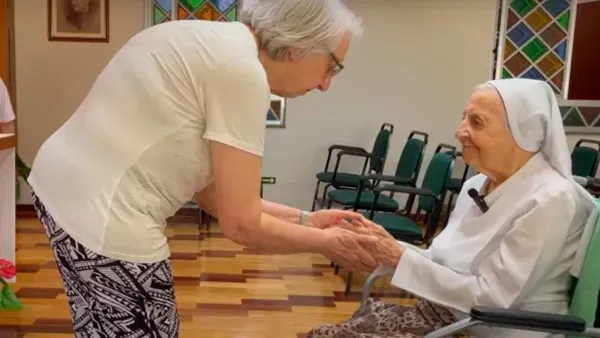World’s oldest nun is 115-year-old Brazilian

 Sister Inah Canabarro and her nephew Kléber Canabarro. / Credit: ACI Digital
Sister Inah Canabarro and her nephew Kléber Canabarro. / Credit: ACI Digital ACI Digital, Mar 20, 2024 / 08:00 am (CNA).
“My secret, my great secret, is to pray,” said Sister Inah Canabarro Lucas, the oldest nun in the world at 115 years of age. “I pray the rosary every day for all the people around the world.”
The Teresian nun is also the oldest person in Brazil and Latin America, according to the Gerontological Research Group.
Sister Inah expressed her good humor and joy in the few words she managed to say in a March 9 interview with ACI Digital, CNA’s Portuguese-language news partner. She repeated a prayer several times to the Virgin Mary, praying to her “for all the people of the entire world.”
The nun currently lives in Porto Alegre in Rio Grande do Sul state in Santo Enrique de Ossó Home, adjacent to the Provincial House of the Teresian Sisters of Brazil, the community she entered in 1927 at the age of 19.
According to the home’s coordinator, Sister Lúcia Ignez Bassotto, Sister Inah “is always focused on others and not on herself.” She is “a very resilient person, isn’t demanding, appreciates everything, thinks that everything is fine, has enormous admiration for the congregation, for the company. She prays for everyone, she is concerned for everyone.”
“Her life is truly exemplary,” continued Sister Lúcia, who has known Sister Inah since she was a student in the town of Sant’Ana do Livramento.

Another characteristic of Sister Inah is that she always wants to be active. She continues to participate in community prayers, and she likes to be in the garden and spend time with her sisters.
Sister Lúcia said that although the elderly nun’s health has declined a little in the last couple of weeks, on the days when she is well she is very talkative and playful.
Until recently, she continued, Sister Inah “painted napkins, made cards, did many things. When she had nothing to do, she would pick up a deck of cards and start playing. If she didn’t have anyone to play with, she would play alone. She had a lot of fun.”
Kind, good-humored her whole life
Inah Canabarro Lucas was born in the town of São Francisco de Assis in west-central Rio Grande do Sul on May 27, 1908, and is the second to last of seven children.
She is the great-great-niece of Gen. David Canabarro, one of the main leaders of the Farroupilha Revolution (1835–1845) in Rio Grande do Sul.
When she was a child, one of her brothers told her mother that Inah could study at a convent in her town. Inah then asked: “What are nuns?” Her mother answered that they were women who dedicated themselves to praying to God, to which she replied: “I’m going to be a nun.”
Sister Inah studied at the nuns’ school and at the age of 19, she went for her novitiate with the Teresian Sisters in Montevideo in Uruguay.
Over more than a century, she has experienced many changes in the world and in the Church. She has lived through two world wars and has seen 10 pontiffs. The year she was born, the pope was St. Pius X.
“Aunt Inah was very skinny and thin since she was a child,” Kléber Canabarro Lucas, 83, the nun’s nephew, told ACI Digital. Due to her frail appearance, everyone thought that she would not live long.
“That’s why she’s been here for 115 years and the rest of the class is all gone,” he remarked.

“Sister Inah is our pinnacle in terms of religiosity, faith, goodwill, a kind and good-humored person; she has been like that all her life. Now the poor thing is declining with age,” he noted.
“But God is going to help her and she is going to turn 116, 117, we are going to be 120, God willing,” the nephew said.
“She is super happy, a person who has life, has love, truly loves,” said Sister Teresinha de Aragón, 83, who has known the nun since she was a child, because her sister was her student at Sant’Ana do Livramento.
The 115-year-old nun is someone “who holds everyone in her heart. There are no exceptions. She treats everyone well, with love, whether they are little ones, adults, or elderly. “She’s a person that loves, she really loves,” Sister Teresinha related.
Sister Inah was a teacher all her life. She taught Portuguese, mathematics, science, history, art, and religion in Teresian schools in Rio de Janeiro, Itaqui, and Sant’Ana do Livramento, a city she loved because it was where she spent most of her life.
According to her nephew, she was “strict, a disciplinarian and affectionate teacher who won over everyone.”
Many of the sisters who currently live at the provincial house in Porto Alegre were the nun’s students or tell stories about how Sister Inah helped them discover their vocation.
Additionally, Sister Inah is one of the few nuns in her congregation who still wears her habit. According to the sisters of her community, since the Second Vatican Council (1963–1965) wearing the habit has been optional. Each person can choose to wear it or not. Since the elderly sister is not fully capable of deciding, and has always worn her habit, her caregivers decided to always dress her in it because it’s the way she has always seen herself, as a religious.
“I feel very happy, very grateful to God because it was [Sister Inah] who guided me along this path and now I can be useful to her, help her in the moments when she needs me,” said Sister Velmira, who is a nurse and in recent years has been the one caring for Sister Inah’s health.
“Mother Inah helped me find this place where I feel so happy, I feel very good with everyone,” she said.
A notable achievement in her life was creating the marching band at Santa Teresa school in Sant’Ana do Livramento. The band played 115 musical instruments and performed throughout Brazil, Uruguay, and Argentina.
She was also a mentor and helped create the famous marching band at the Pomoli Institute in Rivera, Uruguay, the sister city of Sant’Ana do Livramento.
Sister Inah is also an enthusiastic supporter of Sport Clube Internacional, a soccer club founded in 1909 when she was 1 year old.
Apart from saying that she prays for everyone, among the few words that Sister Inah spoke during the interview was also a praise for her favorite team, “because it’s the people’s team, of good, poor, very honest, very good people.”
This story was first published by ACI Digital, CNA’s Portuguese-language news partner. It has been translated and adapted by ACI Prensa/CNA.




